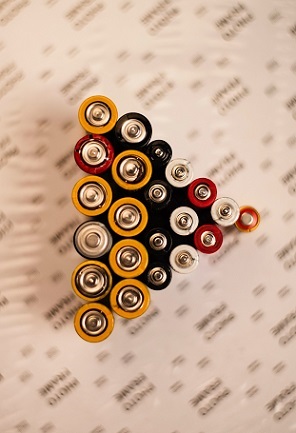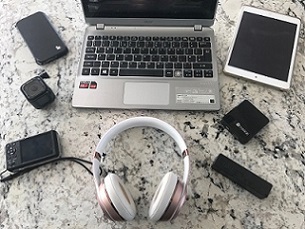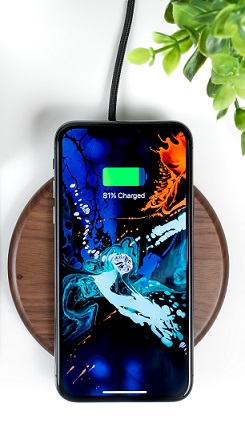 Lithium batteries. Photo by Mohamed Abdelgaffar from Pexels website.
Lithium batteries. Photo by Mohamed Abdelgaffar from Pexels website.
 An AvSax battery fire mitigation bag
An AvSax battery fire mitigation bag
 Just some of the electronic devices regularly brought on board aircraft by passengers
Just some of the electronic devices regularly brought on board aircraft by passengers
 Never use inferior charges or batteries in your mobile phone as they may not meet fire and safety regulations
Never use inferior charges or batteries in your mobile phone as they may not meet fire and safety regulations
The toll of aircraft fires caused by lithium-ion batteries catching fire on board continues to rise with 18 already this year involving planes in US airspace alone.
Even despite Covid and the lack of flights, there were 39 in 2020 and the fires are happening on both passenger and cargo planes every month.
This means that up to June 30, 2021, there have been 322 thermal incidents involving lithium batteries as air cargo or baggage recorded since January 23, 2006. Many of the batteries were in personal electronic devices (PEDS) such as mobile phones, laptops and even e-cigarettes.
More on these incidents below but this is why more and more airline companies have AvSax battery fire mitigation bags on board. AvSax are the world’s best-selling fire containment bag for PEDs on aircraft and are now on more than 15,373 aircraft operated by 80 airline companies. They have been used 33 times to deal with emergencies since the start of 2017 and every time they have been deployed the aircraft has been able to complete its journey safely with no need to divert or make an emergency landing.
AvSax won the prestigious Queen’s Award for Enterprise in the UK in 2018.
The Federal Aviation Administration’s document called Procedures for Fighting In-Flight Fires Associated With Portable Electronic Devices and Lithium Batteries When Using Commercially Marketed Containment Products states: “The risks and safety concerns of lithium-ion batteries in aircraft are well documented.”
It then lays out detailed guidance on how airlines should deal with such emergencies – and typical scenarios are mobile phones or laptops catching fire due to faulty lithium-ion batteries inside them.
The FAA notice states: “Once the fire is extinguished, containment devices can be used to secure the personal electronic device provided it has been adequately cooled to allow transfer to the containment device.
“Keeping an unstable device cool is critical. In order to do so, any such containment device should be capable of holding liquid so that the device can be submerged during storage.”
AvSax fire containment bags manufactured by Environmental Defence Systems Ltd based in Yorkshire, England, do just that.
Here are some of the incidents involving lithium-ion batteries on board planes this year.
In June, while in flight from Charlotte, North Carolina, to the Dominican Republic, a lithium battery powered vape pen started sparking. A flight attendant sprayed a Halon based extinguisher on it and placed it into a containment bag. The plane landed without further incident.
Also in June, a lithium battery power bank started smoking while an aircraft was on the runway preparing for departure. The power bank was placed inside a fire containment bag and the aircraft returned to gate to dispose of the item.
In May, a pair of earphone buds started smoking so were placed in a containment bag. The flight was in the process of pushing when this event happened, causing the flight to return to the gate so the earphones could be taken off the aircraft.
In March 2021 a passenger's vaping device began to overheat in his pocket while in the plane’s lavatory. Flight attendants placed the device in a containment bag. Fire rescue met the aircrew upon landing and disposed of the device
Also in March, a passenger’s mobile phone battery began to burn while in flight over the Gulf of Mexico. Airline personnel extinguished the fire and secured the phone in a thermal containment bag.
In February, a passenger’s phone began to smoke while watching a movie on it in flight. The phone was placed in an inflight containment bag until the flight landed.
In January, there was a thermal event on an aircraft when a pair of earphone buds were being charged by a passenger in flight. The earphones were placed in a thermal containment bag until the smoke was extinguished.
In December 2020, a portable electronic device heated and expanded while in flight. Flight attendants put the battery into a containment bag
This list does not include three major accidents where lithium battery cargo shipments were implicated but not proven to be the source of the fire: An Asiana Airlines 747 near South Korea on July 28, 2011, a UPS 747 on September 3, 2010 and a UPS DC-8 in Philadelphia, PA on February 7, 2006.
Asiana Airlines Flight 991, a Boeing 747-400F cargo aircraft on a flight from Seoul, South Korea, to Shanghai, China, crashed into the sea off Jeju Island in South Korea after suffering a main deck fire. Both pilots, the only two people on board, were killed.
On September 3, 2010, a UPS Boeing 747-400F flying the route between Dubai, United Arab Emirates, and Cologne, Germany, developed an in-flight fire which caused the aircraft to crash, killing both crew members, the only people on board.
UPS flight 1307, a regular night-time package flight from Atlanta to Philadelphia landed in flames after the crew became alerted to a fire in the cargo hold. They managed to escape unhurt although the plane was destroyed.
Aircraft carrying just 100 passengers could have around 300 to 500 lithium batteries on board when you tot up all the laptops, cameras, e-readers, tablets and mobile phones that need them. There is always a possibility that poor quality or damaged batteries can overheat, causing them to go into what is known as thermal runaway which could lead to the device catching fire.
This happens when one cell in a battery overheats it can produce enough heat – up to 900°C (1652°F) – to cause adjacent cells to overheat. This can cause a lithium battery fire with the potential to cause damage to the aircraft and put lives at risk.
How does AvSax work?
If an electronic device starts to seriously overheat or emit smoke the cabin crew will pour at least two litres of water into an AvSax. It is imperative to first knock down the flames from the device using an on board halon or water fire extinguisher, then transfer the device into an AvSax before it reignites. Additional water is then required. The water activates a polymer gel inside the bag causing it to expand around the device. Should the device keep on venting then AvSax is tough enough to absorb the energy.
AvSax cools the batteries in the device, reducing the likelihood of the battery igniting but if it does go into thermal runaway it is all contained within the bag.
AvSax cools the batteries in the device, reducing the likelihood of the battery igniting but if it does go into thermal runaway it is all contained within the bag.